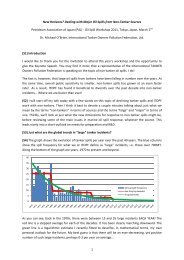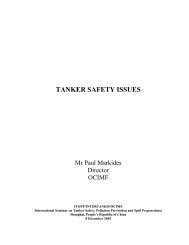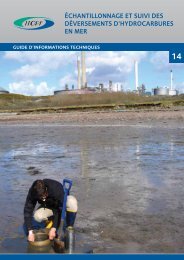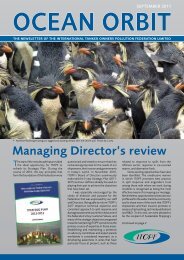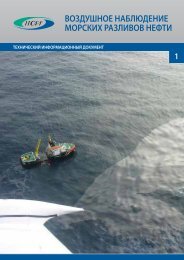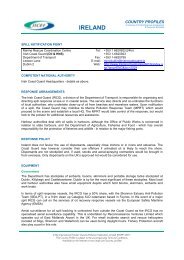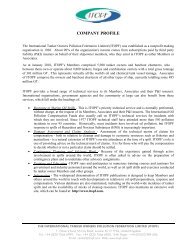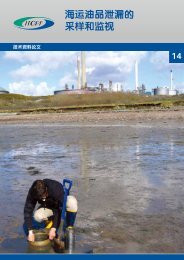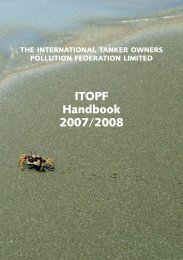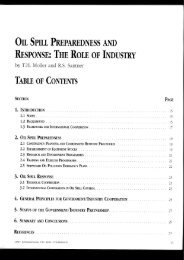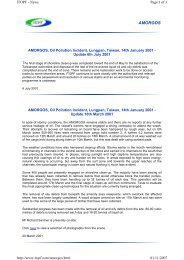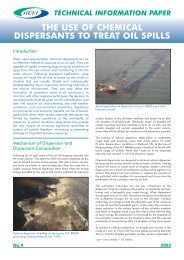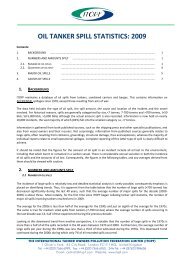Members Handbook 20023 - ITOPF
Members Handbook 20023 - ITOPF
Members Handbook 20023 - ITOPF
Create successful ePaper yourself
Turn your PDF publications into a flip-book with our unique Google optimized e-Paper software.
claimants to provide the P&I insurer and<br />
the 1992 Fund with the information they<br />
require in a format that readily permits<br />
analysis.<br />
For this reason it is vital during any<br />
incident that records are kept of what<br />
was done, when, where and why in<br />
order to support claims for the recovery<br />
of the money spent in clean-up.<br />
Unfortunately, pressures to deal with<br />
practical clean-up problems often result<br />
in record keeping being given less<br />
attention than it deserves. The<br />
appointment of a financial controller<br />
at an early stage of an incident can<br />
be valuable, both to co-ordinate<br />
expenditure and to ensure that<br />
adequate records are maintained.<br />
Bunker Spills Convention<br />
Recognition of the problems that can be<br />
caused by spills of heavy bunker fuel<br />
from non-tankers led to the adoption of<br />
the International Convention on Civil<br />
Liability for Bunker Oil Pollution Damage,<br />
which entered into force in 2008.<br />
This IMO Convention seeks to ensure<br />
that adequate compensation is promptly<br />
available to persons who are required to<br />
clean up or who suffer damage as a<br />
result of spills of ships’ bunker oil, who<br />
would not otherwise be compensated<br />
under the 1992 CLC. Although strict<br />
liability under the Bunker Spills<br />
Convention extends beyond the<br />
registered owner to the bareboat<br />
charterer, manager and operator of the<br />
ship, the Convention only requires the<br />
registered owner of ships greater than<br />
1,000 GT to maintain insurance or other<br />
financial security. The level of cover<br />
must be equal to the limits of liability<br />
under the applicable national or<br />
international limitation regime, but in no<br />
case exceeding the amount calculated<br />
in accordance with the Convention on<br />
Limitation of Liability for Maritime<br />
Claims, 1976, as amended.<br />
HNS Convention<br />
The International Convention on<br />
Liability and Compensation for Damage<br />
in Connection with the Carriage of<br />
Hazardous and Noxious Substances by<br />
Sea (HNS Convention) was adopted by<br />
the IMO in May 1996. It aims to ensure<br />
adequate, prompt and effective<br />
compensation for damage that may<br />
result from shipping accidents involving<br />
hazardous and noxious substances.<br />
The Convention entitles claimants to<br />
compensation for loss or damage to<br />
persons, property and the environment<br />
caused by incidents involving cargoes of<br />
oil, gases and chemicals, plus other<br />
substances which are hazardous in<br />
packaged form. Pollution damage caused<br />
by persistent oils already covered by the<br />
CLC and Fund Convention is excluded,<br />
as is damage caused by radioactive<br />
materials and coal.<br />
The HNS Convention is modelled on the<br />
CLC and Fund Convention. Thus, the<br />
shipowner (and his P&I insurer) is<br />
strictly liable to pay the first tier of<br />
compensation whereas the second tier<br />
35



